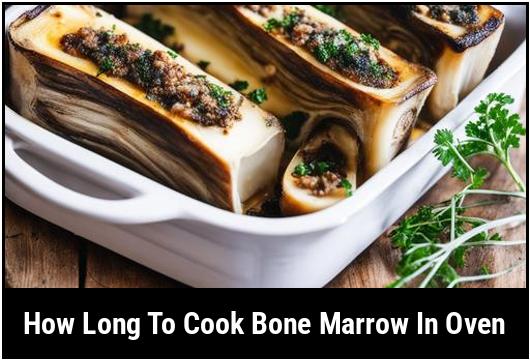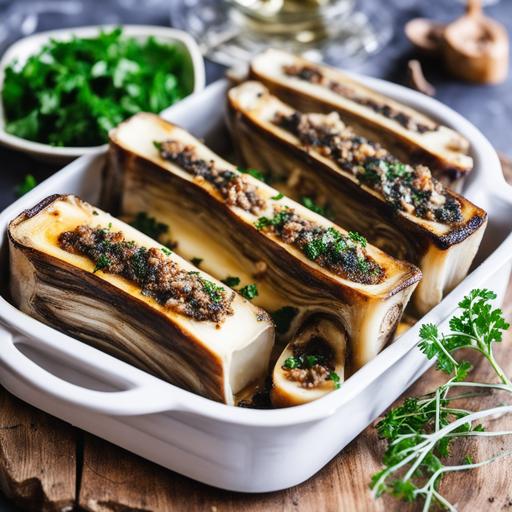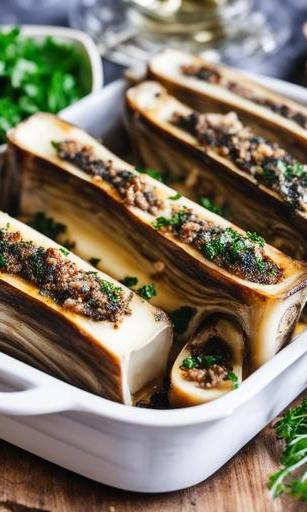[GUIDE] How Long To Cook Bone Marrow In Oven

Cooking bone marrow in the oven allows you to unlock the rich flavors and delicate textures it has to offer. Whether you plan to serve it as an indulgent appetizer or incorporate it into a main course, knowing how to properly cook bone marrow is essential. In this article, we will explore the ideal cooking temperature and time, as well as various cooking techniques and troubleshooting tips to ensure your bone marrow turns out perfect every time.
Quick Answer: How Long To Cook Bone Marrow In The Oven
The approximate cooking time for bone marrow in the oven is 15-20 minutes at a temperature of 425°F (220°C). However, the size and thickness of the bones, as well as personal preference, can affect the cooking time. It is crucial to monitor the bone marrow closely to prevent overcooking, as this can lead to a loss of flavor and undesirable texture.
Key Takeaways
- Cooking bone marrow in the oven takes approximately 15-20 minutes at 425°F (220°C).
- The size and thickness of the bones and personal preference affect cooking time.
- Avoid overcooking bone marrow to maintain its rich flavor and delicate texture.
- Different cooking techniques such as roasting, broiling, or grilling can be used.
- Prepare the bone marrow by soaking it in cold water, or blanching it to remove impurities.
- Serve bone marrow with accompaniments such as crusty bread, herbs, or citrus zest.
The Science Of Cooking Bone Marrow

Before we delve into the cooking process, let’s understand the science behind bone marrow. Bone marrow is a soft, fatty tissue found inside bones, consisting of fat cells, collagen, and blood vessels. When heated, the fat melts, infusing the marrow with a rich, decadent flavor and creating a silky texture.
Choosing the Right Bone Marrow
When selecting bone marrow, opt for bones that are cut lengthwise, such as beef or veal femur or tibia bones. These bones have a large marrow cavity, making them ideal for cooking. Visit your local butcher or supermarket to find bone marrow specifically sold for cooking. Alternatively, you can ask your butcher to prepare bone marrow for you.
Preparing Bone Marrow
Before cooking, bone marrow requires a simple preparation to ensure the best possible flavor and texture. There are two common methods for preparing bone marrow:
- Soaking in Cold Water: Place the bone marrow in a bowl of cold water and allow it to soak for 24-48 hours, changing the water every 12 hours. This process helps remove any blood residue and impurities from the marrow, resulting in a cleaner taste.
- Blanching: Another method to prepare bone marrow is blanching. Bring a pot of water to a boil, then add the bone marrow and boil for 5-10 minutes. Remove the bone marrow and rinse under cold water to halt the cooking process. Blanching is a quicker method and still effectively removes impurities.
After preparing the bone marrow using either method, pat it dry with paper towels before proceeding to cook.
Ideal Cooking Temperature For Bone Marrow

To achieve the perfect balance between melting the fat and retaining the structure of the marrow, a high oven temperature is necessary. The recommended cooking temperature for bone marrow is 425°F (220°C). This temperature provides enough heat to melt the fat and infuse the marrow with flavor while avoiding excessive cooking that can lead to a loss of taste and texture.
Bone Marrow Cooking Time
The cooking time for bone marrow largely depends on the size and thickness of the bones, as well as personal preference. The general guideline for cooking bone marrow in the oven is 15-20 minutes at 425°F (220°C). However, it is crucial to continuously monitor the cooking process to prevent overcooking.
Cooking Techniques

There are several cooking techniques you can employ when cooking bone marrow in the oven. Here are a few popular methods:
- Roasting: The most common technique is roasting. Place the prepared bone marrow bones on a baking sheet, ensuring they are arranged with the marrow side facing up. This allows the fat in the marrow to melt and absorb the flavors from the bone. Roast the bone marrow in a preheated oven at 425°F (220°C) for 15-20 minutes.
- Broiling: Broiling is an alternative method that works well for smaller bone marrow pieces. Preheat the broiler and place the bone marrow on a baking sheet or oven-safe dish. Position the tray or dish on the top rack, directly under the heat source. Broil the bone marrow for approximately 5-7 minutes, or until the desired level of browning and melting is achieved.
- Grilling: Grilling bone marrow adds a smoky flavor and caramelization. Prepare the bone marrow as mentioned earlier and place it marrow side up on a preheated grill over medium-high heat. Grill the bone marrow for around 5-7 minutes, flipping once to ensure even cooking.
Monitoring And Troubleshooting
It is important to monitor the bone marrow closely while cooking to achieve the desired texture and flavor. Here are a few tips to help you troubleshoot common issues:
- Overcooking: Avoid overcooking bone marrow as it can result in loss of flavor and a greasy texture. Monitor the cooking time carefully, and consider removing the bone marrow from the oven a minute or two earlier if it seems to be nearing completion.
Pro Tip: “If you accidentally overcook the bone marrow, you can still salvage it. Remove the marrow from the oven, allow it to cool slightly, and then refrigerate it. Once chilled, you can use it in various recipes, such as adding it to sauces, soups, or stews.”
- Undercooking: If the bone marrow is not fully melted and lacks flavor, it may be undercooked. Extend the cooking time by a few minutes until the desired texture and flavor are achieved. Remember to keep a close eye on the marrow to avoid overcooking during the extended time.
Bone Marrow Cooking Instructions

Here’s a step-by-step guide to cooking bone marrow in the oven:
- Preheat your oven to 425°F (220°C).
- Prepare the bone marrow by either soaking it in cold water for 24-48 hours (changing the water every 12 hours) or blanching it for 5-10 minutes.
- Pat the bone marrow dry with paper towels.
- Arrange the prepared bone marrow bones on a baking sheet or in an oven-safe dish, ensuring the marrow side is facing up.
- Place the baking sheet or dish in the preheated oven and cook for 15-20 minutes, or until the marrow is nicely melted and slightly browned.
- Remove the bone marrow from the oven and let it rest for a few minutes before serving.
Variations
While the classic way to cook bone marrow is in its pure form, there are various ways to add different flavors and textures. Here are some popular variations:
- Gremolata Topping: Sprinkle a gremolata mixture consisting of finely chopped garlic, lemon zest, and parsley over the cooked bone marrow. The gremolata adds a refreshing citrusy flavor that complements the richness of the marrow.
- Herb Butter: Prepare a compound butter by combining softened unsalted butter with finely chopped herbs like thyme, rosemary, or chives. Place a small slice of the herb butter on top of each bone marrow bone before cooking. The butter will melt and infuse the marrow with aromatic flavors.
- Toasted Breadcrumbs: Toss breadcrumbs with melted butter or olive oil and toast them until golden brown. Sprinkle the toasted breadcrumbs over the cooked bone marrow to add a delightful crunchy texture.
When Things Go Wrong

Despite your best efforts, things can go wrong when cooking bone marrow. Here are a few common issues and ways to address them:
- Marrow Stuck to Bone: If the marrow sticks to the bone after cooking, use a small spoon or knife to gently scrape it out. The marrow should release easily, but be cautious not to disturb the structure of the bone.
- Bland Flavor: If the bone marrow lacks flavor, it may not have been cooked long enough. To enhance the taste, sprinkle a pinch of sea salt or drizzle a few drops of balsamic vinegar over the melted marrow before serving.
- Excessive Greasiness: If the bone marrow turns out too greasy, you can blot it with a paper towel before serving to absorb some of the excess oil.
Serving Bone Marrow
Bone marrow is often served as a decadent appetizer or incorporated into main dishes. Here are some serving suggestions:
- Classic Preparation: Serve the bone marrow as it is, with accompanied crusty bread slices to spread the melted marrow onto. Garnish with freshly chopped herbs such as parsley, chives, or thyme.
- Soup Enhancer: Add cooked bone marrow to soups or stews to enrich their flavor and add a velvety texture. Simply spoon the melted marrow into the soup or stew before serving.
- Topping for Steak: Top a perfectly cooked steak with a generous dollop of bone marrow to add an indulgent touch. Allow the warmth of the steak to melt the bone marrow slightly, enhancing the flavors of both elements.
Best Practices For Bone Marrow Cooking

To ensure successful bone marrow cooking, keep the following best practices in mind:
- Preparing the bone marrow by soaking or blanching removes impurities and enhances the taste.
- Use a high oven temperature (425°F / 220°C) to melt the fat and develop the desired flavors.
- Monitor the cooking time closely to avoid overcooking or undercooking the bone marrow.
- Experiment with different cooking techniques, such as roasting, broiling, or grilling, to achieve unique flavors and textures.
- Add accompaniments such as crusty bread, herbs, or citrus zest to enhance the overall dining experience.
Conclusion
Cooking bone marrow in the oven requires precision and attention to detail, but the effort is well worth it. By following the recommended temperature and cooking time, as well as considering different preparation methods and variations, you can create a delectable dish that showcases the richness and delicate texture of bone marrow. Whether enjoyed on its own or incorporated into other recipes, bone marrow is a culinary delight that will surely impress your guests.
FAQS
What Is Bone Marrow And Why Is It Cooked In The Oven?
Bone marrow is the soft and fatty tissue inside the bones of animals such as cows, pigs, and chicken. It is cooked in the oven to render the fat and soften the marrow, making it easier to remove and eat.
How Long Should Bone Marrow Be Cooked In The Oven And At What Temperature?
The recommended cooking time for bone marrow in the oven is 20-25 minutes at 450°F or until the marrow is tender and the fat has rendered. However, cooking times may vary depending on the thickness of the bones and individual oven temperatures.
What Is The Best Way To Prepare Bone Marrow For Cooking In The Oven?
To prepare bone marrow for cooking in the oven, use a sharp knife to cut the bones into pieces, usually about 2-3 inches long. Soak them in cold water for several hours or overnight to remove any blood or impurities. Before cooking, season the marrow with salt and pepper or other desired spices.
What Are Some Common Dishes That Use Bone Marrow As An Ingredient?
Bone marrow is a versatile ingredient that can be used in a variety of dishes, including soups, stews, sauces, and spreads. It is commonly used to add richness and depth of flavor to dishes such as bone marrow butter, bone broth, and beef pho.
Is Bone Marrow Healthy To Eat And What Are The Nutritional Benefits?
Bone marrow is a nutrient-dense food that contains vitamins and minerals such as calcium, iron, and vitamin B12. It is also rich in healthy fats, which can support heart health and brain function. However, because of its high fat content, it should be consumed in moderation as part of a balanced diet.
Sources
About the Author Jenny
I'm Jenny, a housewife with an unwavering passion for food. My culinary journey began with my grandmother's kitchen, and it's now a full-fledged food blog. I've turned my love for cooking into a creative outlet, sharing recipes and stories with a global community of fellow food enthusiasts. It's proof that being a housewife can also mean pursuing your passions and savoring life's delectable moments.
